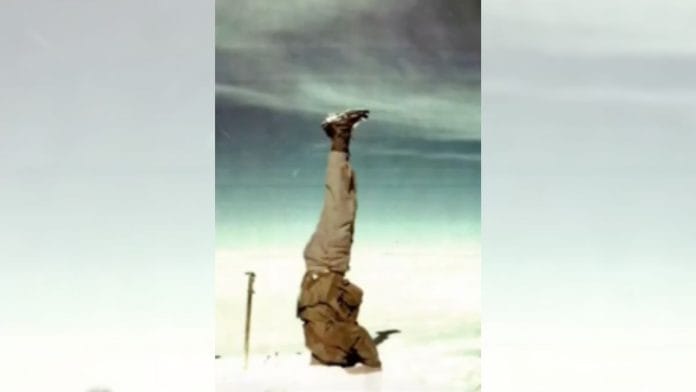Picture this: It is 1951 and a 27-year-old Indian man is standing on his head, with his feet high up on the snow-clad summit mountains of Trisul. It was Gurdial Singh and his headstand marked “the beginning of the age of mountaineering for Indians.”
Singh became the first Indian to have climbed a major Himalayan mountain and later mentored many others to do the same. It is fitting, then, that he was called “Guru” by those who knew him.
Singh’s historic 1951 ascent also helped him join the elite English Alpine Club. It was “a club of English gentlemen devoted to mountaineering” and he joined it in 1952, becoming the first Indian to do so.
Singh grew up in the plains of Punjab and was only introduced to mountaineering when he did his Masters in geography at Aligarh Muslim University. At 21, the soon-to-be mountaineer worked as a geography teacher at The Doon School. But his love for the subject went far beyond the classroom, up to the mighty Himalayas. He was inspired by other professors at the school, John Martyn, Jack Gibson, and RL Holdsworth, who was a well-known mountaineer at the time.
Singh’s mountaineering adventures commenced modestly, with treks in Kashmir that gradually progressed to more challenging expeditions. Three years into his job, he had explored the Sonamarg region with fellow climbers.
He embarked on his first real expedition to Bandarpunch in 1950, where he was joined by then-unknown Tenzing Norgay. Singh described Tenzing as “the most modest human being conceivable” whose “broad smile won over people in a big way”, wrote Suman Dubey in The Himalayan Journal.
Singh’s celebratory headstand on the summit of Trisul became an iconic image capturing his audacious spirit and love for the mountains. He subsequently contributed to expeditions to Kamet and Manasarovar before making the first ascent of Mrigthuni in 1958.
In 1960, driven by his deep fascination for Nanda Devi, Singh organised an expedition to the unclimbed Devistan I, standing at 6,678 metres. This significant endeavour marked his first foray into the revered Nanda Devi Sanctuary.
The following year, in 1961, Singh led an expedition to Nanda Devi itself, an experience he holds among his most cherished memories, according to Dubey. His team soon realised they couldn’t scale the incredibly tall mountains in the monsoons, but Singh took the opportunity to educate his fellow teammates on the variety and beauty of the Himalayan wildflowers in bloom.
Aged 38, Singh was the oldest and most experienced climber in the 1962 expedition to Everest. Dubey described him as well-equipped with the endurance and stamina required to conquer the peak. He recounted how Singh’s motivation wasn’t fueled by the desire to summit the peak. Rather, he joined the summit party at the insistence of his close friend and expedition leader, Major John Dias. “Gurdial climbed for pleasure, to enjoy the mountains in the company of friends, to savour the beauty and grandeur of the high ranges, not to find fame or bag summits,” Dubey wrote.
Singh lived a “life of exploration, travelling where few have been before.”
While Singh didn’t seek fame, it found him nonetheless. He received the Arjuna Award in 1965, the Padma Shri in 1967, and the Lifetime Achievement Award and Tenzing Norgay National Adventure Award in 2007.
Recalling a warm and amusing incident, Singh’s nephew Harpal Singh told The Tribune about a memorable trip to Delhi where Singh met former Prime Minister Rajiv Gandhi. Harpal shared that Singh was smiling the entire time after the meeting. During their interaction, Gandhi chose to sit beside Singh, who addressed him by his first name.
Also read: Nepal sherpa scales Everest for record 30th time; two climbers go missing
A teacher to many
Beyond his climbing exploits, Singh was also dedicated to promoting mountaineering education and training in India. He was Vice President of the Indian Mountaineering Foundation (IMF) and was closely associated with the Himalayan Mountaineering Institute (HMI) in Darjeeling, where he mentored and trained numerous aspiring climbers.
“He was the man to go for all members of the IMF at the time of crisis,” Mandeep Singh Soin, a mountaineer, said.
Singh worked at The Doon School from 1945 to 1979, where he was in charge of geography instruction and swimming coaching. In recognition of his abilities as a teacher, he was granted a year-long opportunity by the British Council in 1957 to attend Gordonstoun. This was a Scottish institution established by the German educator Kurt Hahn, renowned for its focus on athletic pursuits and rigorous outdoor activities. Here, he conquered several Munroes—Scottish peaks—including Ben Nevis, the UK’s highest summit.
“Gurdial was an inspirational personage in one’s little life. He introduced us to birds, trees, wildflowers, dark forests, alpine meadows, Himalayan glaciers and the high mountains beyond, and the value these lend to our lives,” Captain Alok Chandola (retd), a student of Singh’s told The Tribune.
Singh never married; he often said he was married to the mountains. He died on 30 May 2023 in Chandigarh following complications due to a hip fracture and chikungunya.
Comparing him to mountain climbers today, who scale Everest mainly for popularity, Soin said Singh was different.
“His love for mountains was never for fame.”
(Edited by Prasanna Bachchhav)






